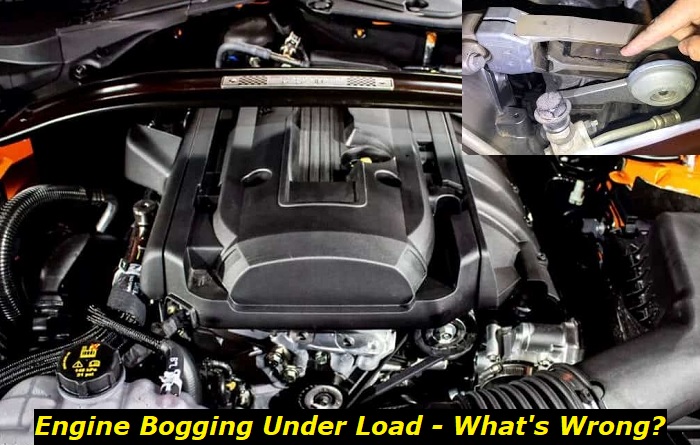If you are experiencing problems with the engine, particularly when it bogs down under load, that could mean a lot of things going on in your engine. Although we can't exactly pinpoint the part causing your auto to behave that way, we have compiled the factors that are most likely to result in such a scenario.
Engine noises highlights
- Level of importance:High
- Commonreasons:All kinds of various problems, hard to list promptly
- DIY inspection:Possible but may be complicated
- DIY repair:Impossible, in most cases
- Price for repair:$150 - $1,000
- Can you drive?Usually, yes
- Ways to fix:Locate the source for the sound and repair the system that needs help

1. Fuel Pressure Issue at Full Throttle
First on our list of suspects for this problem is a possible issue with fuel pressure at full throttle. Diagnosing a fuel pressure issue on a car engine can be done by observing the visual cues, recognizing the symptoms, and using tools. If the engine is bogging under load, this could indicate that there is low fuel pressure or poor atomization of fuel in the combustion chamber.
Start by visually inspecting the fuel line for any kinks, cracks, or obstructions that may cause air to enter the system. Low fuel pressure will also reduce the vaporization of the gasoline and prevent proper mixing with air which results in an inadequate burn rate and reduced power output.
To accurately measure fuel pressure levels, use a fuel pressure gauge connected directly to the Schrader valve located near the carburetor or injector rail. When testing, ensure that the engine is at full throttle and that there is sufficient fuel pressure to maintain the proper atomization of fuel.
If any issues with fuel pressure are indicated, it may be necessary to replace certain parts in order to restore peak performance. This can include replacing or inspecting the following components: injectors, carburetor, fuel pump, filter, and regulator. If the parts appear to be functioning properly, then further inspection of the fuel line should take place to ensure that no air is entering the system.
Following this procedure will help establish an ideal balance between airflow and fuel flow for maximum power output when the car engine is under load at full throttle. As always, confirm all repairs before attempting a test drive on public roads. It is important to note that any issues with fuel pressure at full throttle should be properly diagnosed and rectified to ensure optimal engine performance and safety.
2. Fuel Pressure Regulator Leak
If a car engine bogs under load, it is likely that a fuel pressure regulator leak is the culprit. To diagnose this problem manually, start by inspecting the fuel system for signs of leakage.
A common symptom of such leaks includes black smoke from the tailpipe and/or a smell of gasoline near the engine. If these symptoms are present, then check to see if there is any debris or dirt on the injectors or fuel rails because this could indicate a potential leak from the regulator.
It would be a good idea to attach an automotive diagnostic scanner to your vehicle and note any codes that may appear in relation to fuel pressure, too.
To fix this issue, replace any faulty parts including the fuel pressure regulator if necessary. The part can be easily identified as it is usually located in the fuel rail and is typically connected to a vacuum line.
Once replaced, it is also advisable to replace any deteriorated or damaged O-rings on the regulator as well as any seals that may be leaking. Additionally, if the injectors are clogged or dirty, they should be cleaned or replaced as well.
After that, check all connections between hoses and double-check for any cracks or loose fittings. After these steps have been taken, restart the vehicle and observe whether the problem has been resolved. If not, contact an expert mechanic for assistance.
If done correctly and with proper care, replacing the fuel pressure regulator leak can help restore your car engine's performance and prevent further damage from occurring. Taking the time to properly diagnose and repair the issue can save you from potentially costly repairs down the line.
Furthermore, if done correctly, it helps prevent further potential damage that may be caused by inadequate fuel pressure delivery. Taking all these factors into account, replacing a faulty fuel pressure regulator leak is an important step in avoiding more serious issues with your car engine.
3. Fuel Injector Stuck in Open
Assessing the quality of a fuel injector stuck in open can be done using visual hints, symptoms, and various tools. An experienced mechanic will typically check for signs of leaking fuel from the injector seals, as well as inspect for any abnormal wear or corrosion on the casing of the injector itself.
Additionally, certain engine diagnostic tools such as multi-meters may be used to measure current resistance through the fuel injectors.
The most common cause of a fuel injector stuck in open is an internal fault due to debris build-up or a mechanical malfunction. Other possible causes include electrical problems such as faulty wiring or a bad ground connection, vacuum leaks in intake manifold gaskets, clogged filters, and low fluid levels in the fuel injector system.
To fix a stuck fuel injector, the troublesome part must first be identified and replaced. If the issue is related to electrical problems such as faulty wiring or bad ground connections, those components should be examined and repaired if needed.
On the other hand, vacuum leaks in intake manifold gaskets can often be fixed with a replacement gasket set or by using sealant on them. Then, clogged filters may need to be thoroughly cleaned or completely replaced. Likewise, low fluid levels in the fuel injector system can usually be remedied with a simple top-up of fluid from the manufacturer's recommended grade for your specific engine type.
The parts that tend to fail in the injectors most commonly include seals, O-rings, connectors, solenoids, and nozzles. Depending on the type of fuel injector, it may be possible to repair or rebuild them by replacing these parts rather than purchasing a new one.
In either case, if unsure of how to proceed, consulting an experienced mechanic is always the best course of action. They will be able to pinpoint the root cause and provide guidance on how to fix any underlying issues.
It is also important to note that many newer cars use electronic fuel injection as opposed to mechanical pumps, so check your owner's manual for information related specifically to your vehicle before attempting any repairs yourself.
4. Faulty Throttle Body
Diagnosing a faulty throttle body is fairly straightforward. Generally, the symptom of a malfunctioning unit will be an engine that bogs down under load or when accelerating. To confirm this diagnosis, check the electrical connections to the throttle body and look for signs of corrosion or loose connections.
In addition, if codes are present in the car's computer system related to throttle position sensors or other components associated with the throttle body, further investigation is warranted.
Throttle bodies can suffer from wear over time because they often contain small moving parts that can become stuck or malfunction due to the build-up of dirt and grime. This may require replacing certain parts inside the throttle body such as the throttle position sensor, idle air control valve, electronic actuator motor, and even the throttle plate itself.
If these parts are not functioning optimally, the engine will bog down under load or during acceleration due to a lack of air being supplied to the engine. Ultimately, replacing or cleaning the faulty components should resolve this issue.
It is also important for mechanics to inspect other parts that may be contributing to a faulty throttle body such as vacuum hoses, intake manifold gaskets, and air filter housing. If any one of these components is malfunctioning or damaged it can prevent proper airflow from reaching the throttle body leading to similar symptoms as if it was actually damaged.
Therefore, if all electrical connections have been checked with no signs of issues and other components appear sound, further investigation into each part must be done to find the source of the problem.
In some cases, a faulty throttle body may require complete replacement and it is important for mechanics to have an understanding of the right type and size that should be installed on the vehicle.
Different vehicles require different sizes and configurations, so choosing the wrong one can result in similar symptoms as before or even worse problems such as engine stalling or hesitation during acceleration.
Moreover, when replacing any parts within the throttle body it is essential to use genuine parts which are made specifically for that car model as aftermarket replacements may not fit correctly.
Once all components are checked and replaced if necessary, then testing of the unit should confirm whether or not it is functioning properly. If everything appears good, then the engine should run without bogging down under load or when accelerating.
5. Bad Throttle Position Sensor
The throttle position sensor (TPS) is an important component of the fuel injection system because it helps regulate the amount of air entering the engine. If this part malfunctions or fails, then the vehicle may experience rough idle, poor acceleration, and a decrease in fuel economy due to incorrect readings being sent to the ECU.
Consequently, it is important for mechanics to correctly diagnose any issues related to this part.
To determine if a malfunctioning TPS is causing problems with your car's performance, connect an OBD-II scanner and check for codes related to throttle position sensors or other components associated with it.
If any codes are present relating to these parts then further testing must be done to pinpoint the root cause. Additionally, if the TPS is physically damaged then it must be replaced with a genuine part that has been made specifically for your car.
Once all components have been tested and replaced, then further testing should be done to make sure that the car is running properly without any issues. If everything appears good, then the engine should run without bogging down under load or when accelerating.
Conclusion
As shown here, there are many reasons why your engine is bogging down under load. These can range from mechanical and electrical problems. At times, it can be a combination of both when the sensors fail as well as the mechanical parts.
No matter what the root of the problem is, be sure to bring your vehicle to a certified mechanic or technician right away to confirm your suspicions. Sometimes, there are also other factors at play aside from the primary elements mentioned here, so having someone with expertise and specialized tools can help you detect them, too, and will let you avert a looming disaster with your engine.
About the authors
The CarAraC research team is composed of seasoned auto mechanics and automotive industry professionals, including individuals with advanced degrees and certifications in their field. Our team members boast prestigious credentials, reflecting their extensive knowledge and skills. These qualifications include: IMI: Institute of the Motor Industry, ASE-Certified Master Automobile Technicians; Coventry University, Graduate of MA in Automotive Journalism; Politecnico di Torino, Italy, MS Automotive Engineering; Ss. Cyril and Methodius University in Skopje, Mechanical University in Skopje; TOC Automotive College; DHA Suffa University, Department of Mechanical Engineering






Add comment